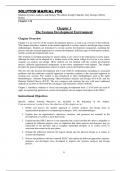Exam (elaborations)
Solution Manual For Modern Systems Analysis and Design, 9th Edition by Joseph Valacich, Joey George, Jeffrey Hoffer Chapter 1-14
- Module
- Institution
- Book
Solution Manual For Modern Systems Analysis and Design, 9th Edition by Joseph Valacich, Joey George, Jeffrey Hoffer Chapter 1-14
[Show more]



